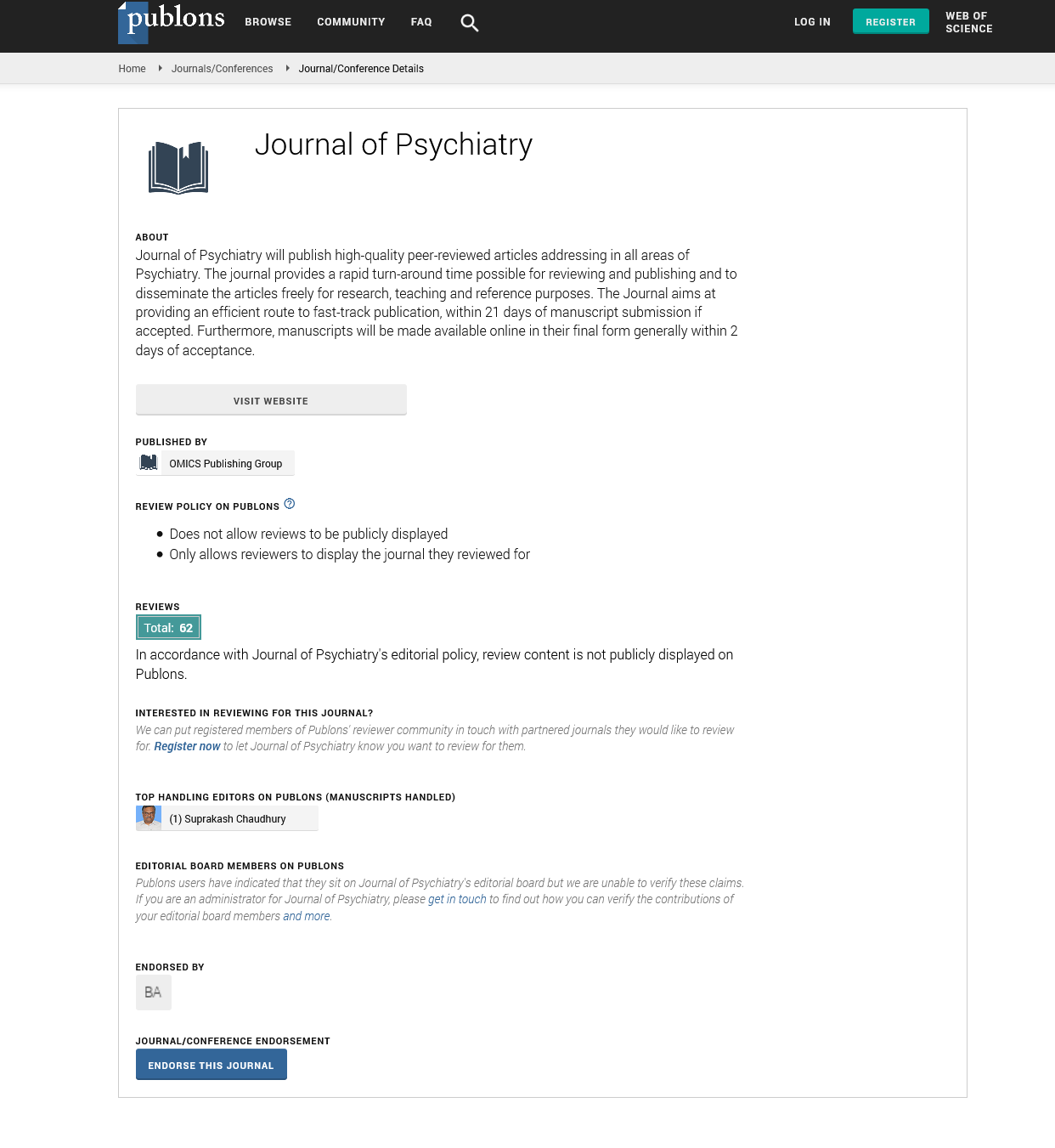Indexed In
- RefSeek
- Hamdard University
- EBSCO A-Z
- OCLC- WorldCat
- SWB online catalog
- Publons
- International committee of medical journals editors (ICMJE)
- Geneva Foundation for Medical Education and Research
Useful Links
Share This Page
Open Access Journals
- Agri and Aquaculture
- Biochemistry
- Bioinformatics & Systems Biology
- Business & Management
- Chemistry
- Clinical Sciences
- Engineering
- Food & Nutrition
- General Science
- Genetics & Molecular Biology
- Immunology & Microbiology
- Medical Sciences
- Neuroscience & Psychology
- Nursing & Health Care
- Pharmaceutical Sciences
Perspective - (2022) Volume 25, Issue 9
Investigation of Stability in Trait of Social, State and Depressive Anhedonia and their Relationships with Psychopathology Symptoms
Long Miao*Received: 01-Sep-2022, Manuscript No. JOP-22-18458; Editor assigned: 05-Sep-2022, Pre QC No. JOP-22-18458(PQ); Reviewed: 19-Sep-2022, QC No. JOP-22-18458; Revised: 26-Sep-2022, Manuscript No. JOP-22-18458(R); Published: 03-Oct-2022, DOI: 10.35248/2378-5756.22.25.532
About the Study
Reduced pleasure-seeking behaviour, or anhedonia, has been identified as a key sign of adolescent autistic spectrum disorder, major depressive disorder, smoking, suicidality, and posttraumatic stress disorder. Despite anhedonia's significance for psychopathology, it is poorly understood due to numerous conceptual and methodological difficulties.
Anhedonia is mostly investigated as a trait construct in relation to research on schizophrenia, depression, and other diseases. Anhedonia has typically been viewed in these researches as a persistent trait that triggers the onset of psychotic symptoms and biological susceptibility to the emergence of mental diseases. Anhedonia in both its condition and its trait form, however, differs in how well it predicts the development of depression over a ten-year period, according to a longitudinal study. On the other hand, some studies have claimed that when studying the association between personality and psychopathology, trait-level categories are not as specific as tests that include self-report of recent changes. With regard to anhedonia, this seems especially true. A decline in the capacity to experience pleasure, as determined by the clinical diagnostic evaluation, is a sign of anhedonia.
This is a crucial clinical distinction since trait and state anhedonia assessments instead assess cross-sectional sensations across a specific period of time rather than baseline alterations. In the same way, alterations in anhedonia might be crucial to understanding anhedonia and mental disease. Previous research revealed that recent changes in anhedonia were a key indicator of depressive symptoms, suicidal thoughts, and anxiety. It was argued that recent alterations in anhedonia might be specifically predictive of important aspects of psychopathology. These results imply that it is vital to distinguish between trait, state, and recent changes in anhedonia when investigating the condition, and that recent change in anhedonia may be a better indicator of psychological illnesses than trait and state anhedonia. Almost all anhedonia self-report measures have been created for adults.
Two anhedonia scales for teenagers have recently been developed and verified. The Anticipatory and Consummatory Interpersonal Pleasure Scale is one such tool that includes a trait experience of social pleasure's absence. Higher levels of social anhedonia were linked to less depressive symptoms and a bigger negative dimension of schizotypy. Trait social anhedonia has been documented in adolescents from Spain, the United States, and China. General anhedonia may not be as connected to metal diseases as social anhedonia. The Snaith-Hamilton Pleasure Scale (SHAPS), which assesses general anhedonia as well as interest, sensory experience, and recent food intake, is another tool. State anhedonia was linked to more severe depression, suicidal thoughts, and addictive behaviours, according to studies utilising the SHAPS.
Depending on the type of anhedonia, there were various connections between it and other psychopathological traits. While disorganised schizotypy and affective symptoms were directly linked to increases in depressed anhedonia, negative schizotypy was specifically linked to increases in trait social and state anhedonia. Research demonstrating that anhedonia is different across psychiatric diseases, depending on which regions of the pleasure networks are most impaired, supports this conclusion. In fact, recent increases in anhedonia are predictive of symptoms that are more suggestive of depression and suicidal ideation, whereas more trait-like expression of social anhedonia and physical-related hedonic deficits emerge more robustly in relation to schizophrenia-spectrum symptoms. The idea put forth by Loas is that while state anhedonia indicates acute anhedonic states, trait anhedonia reflects chronic anhedonic situations.
State anhedonia may be more directly linked to adolescent affective disorders, whereas trait anhedonia may be more closely linked to schizophrenia-spectrum illnesses. Additionally, state anhedonia measured by the SHAPS had the same negative schizotypy effects as trait anhedonia. This might be because, in contrast to depressive anhedonia, the SHAPS did not clearly distinguish between state and trait anhedonia.
Citation: Miao L (2022) Investigation of Stability in Trait of Social, State and Depressive Anhedonia and their Relationships with Psychopathology Symptoms. J Psychiatry. 25:532.
Copyright: © 2022 Miao L. This is an open-access article distributed under the terms of the Creative Commons Attribution License, which permits unrestricted use, distribution, and reproduction in any medium, provided the original author and source are credited.

